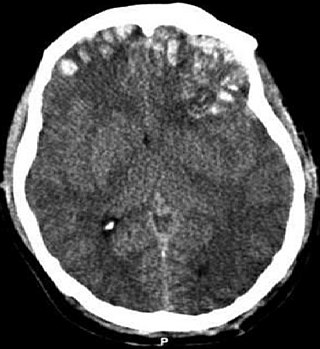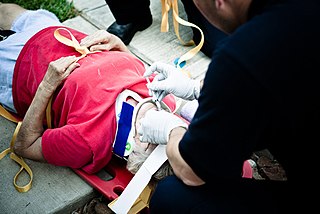Related Research Articles
Hemiparesis, or unilateral paresis, is weakness of one entire side of the body. Hemiplegia is, in its most severe form, complete paralysis of half of the body. Hemiparesis and hemiplegia can be caused by different medical conditions, including congenital causes, trauma, tumors, or stroke.
Post-traumatic stress disorder (PTSD) is a mental and behavioral disorder that can develop because of exposure to a traumatic event, such as sexual assault, warfare, traffic collisions, child abuse, domestic violence, or other threats on a person's life. Symptoms may include disturbing thoughts, feelings, or dreams related to the events, mental or physical distress to trauma-related cues, attempts to avoid trauma-related cues, alterations in the way a person thinks and feels, and an increase in the fight-or-flight response. These symptoms last for more than a month after the event. Young children are less likely to show distress but instead may express their memories through play. A person with PTSD is at a higher risk of suicide and intentional self-harm.
The Glasgow Coma Scale (GCS) is a clinical scale used to reliably measure a person's level of consciousness after a brain injury.
Activities of daily living is a term used in healthcare to refer to people's daily self-care activities. Health professionals often use a person's ability or inability to perform ADLs as a measurement of their functional status. The concept of ADLs was originally proposed in the 1950s by Sidney Katz and his team at the Benjamin Rose Hospital in Cleveland, Ohio. The concept of ADLs has been added to and refined by a variety of researchers since that time. For example, many indexes that assess ADLs now include some measure of mobility. Additionally, to be more inclusive of the range of activities that support independent living, in 1969, Lawton and Brody developed the instrumental activities of daily living (IADLs). ADLs are often used in the care of people with disabilities, people with injuries, and elderly people. Younger children often require help from adults to perform ADLs, as they have not yet developed the skills necessary to perform them independently.

A concussion, also known as a mild traumatic brain injury (mTBI), is a head injury that temporarily affects brain functioning. Symptoms may include loss of consciousness (LOC); memory loss; headaches; difficulty with thinking, concentration, or balance; nausea; blurred vision; sleep disturbances; and mood changes. Any of these symptoms may begin immediately, or appear days after the injury. Concussion should be suspected if a person indirectly or directly hits their head and experiences any of the symptoms of concussion. It is not unusual for symptoms to last 2 weeks in adults and 4 weeks in children. Fewer than 10% of sports-related concussions among children are associated with loss of consciousness.

Spirometry is the most common of the pulmonary function tests (PFTs). It measures lung function, specifically the amount (volume) and/or speed (flow) of air that can be inhaled and exhaled. Spirometry is helpful in assessing breathing patterns that identify conditions such as asthma, pulmonary fibrosis, cystic fibrosis, and COPD. It is also helpful as part of a system of health surveillance, in which breathing patterns are measured over time.

Major trauma is any injury that has the potential to cause prolonged disability or death. There are many causes of major trauma, blunt and penetrating, including falls, motor vehicle collisions, stabbing wounds, and gunshot wounds. Depending on the severity of injury, quickness of management, and transportation to an appropriate medical facility may be necessary to prevent loss of life or limb. The initial assessment is critical, and involves a physical evaluation and also may include the use of imaging tools to determine the types of injuries accurately and to formulate a course of treatment.

A spinal cord injury (SCI) is damage to the spinal cord that causes temporary or permanent changes in its function. Symptoms may include loss of muscle function, sensation, or autonomic function in the parts of the body served by the spinal cord below the level of the injury. Injury can occur at any level of the spinal cord and can be complete, with a total loss of sensation and muscle function at lower sacral segments, or incomplete, meaning some nervous signals are able to travel past the injured area of the cord up to the Sacral S4-5 spinal cord segments. Depending on the location and severity of damage, the symptoms vary, from numbness to paralysis, including bowel or bladder incontinence. Long term outcomes also range widely, from full recovery to permanent tetraplegia or paraplegia. Complications can include muscle atrophy, loss of voluntary motor control, spasticity, pressure sores, infections, and breathing problems.

A traumatic brain injury (TBI), also known as an intracranial injury, is an injury to the brain caused by an external force. TBI can be classified based on severity, mechanism, or other features. Head injury is a broader category that may involve damage to other structures such as the scalp and skull. TBI can result in physical, cognitive, social, emotional and behavioral symptoms, and outcomes can range from complete recovery to permanent disability or death.
Neuroplasticity, also known as neural plasticity, or brain plasticity, is the ability of neural networks in the brain to change through growth and reorganization. It is when the brain is rewired to function in some way that differs from how it previously functioned. These changes range from individual neuron pathways making new connections, to systematic adjustments like cortical remapping. Examples of neuroplasticity include circuit and network changes that result from learning a new ability, environmental influences, practice, and psychological stress.

Blunt trauma, also known as blunt force trauma or non-penetrating trauma, is physical traumas, and particularly in the elderly who fall. It is contrasted with penetrating trauma which occurs when an object pierces the skin and enters a tissue of the body, creating an open wound and bruise.
Hypnotic susceptibility measures how easily a person can be hypnotized. Several types of scales are used; however, the most common are the Harvard Group Scale of Hypnotic Susceptibility and the Stanford Hypnotic Susceptibility Scales.
Post-traumatic amnesia (PTA) is a state of confusion that occurs immediately following a traumatic brain injury (TBI) in which the injured person is disoriented and unable to remember events that occur after the injury. The person may be unable to state their name, where they are, and what time it is. When continuous memory returns, PTA is considered to have resolved. While PTA lasts, new events cannot be stored in the memory. About a third of patients with mild head injury are reported to have "islands of memory", in which the patient can recall only some events. During PTA, the patient's consciousness is "clouded". Because PTA involves confusion in addition to the memory loss typical of amnesia, the term "post-traumatic confusional state" has been proposed as an alternative.

A pulmonary contusion, also known as lung contusion, is a bruise of the lung, caused by chest trauma. As a result of damage to capillaries, blood and other fluids accumulate in the lung tissue. The excess fluid interferes with gas exchange, potentially leading to inadequate oxygen levels (hypoxia). Unlike pulmonary laceration, another type of lung injury, pulmonary contusion does not involve a cut or tear of the lung tissue.

Dental trauma refers to trauma (injury) to the teeth and/or periodontium, and nearby soft tissues such as the lips, tongue, etc. The study of dental trauma is called dental traumatology.

Geriatric trauma refers to a traumatic injury that occurs to an elderly person. People around the world are living longer than ever. In developed and underdeveloped countries, the pace of population aging is increasing. By 2050, the world's population aged 60 years and older is expected to total 2 billion, up from 900 million in 2015. While this trend presents opportunities for productivity and additional experiences, it also comes with its own set of challenges for health systems. More so than ever, elderly populations are presenting to the Emergency Department following traumatic injury. In addition, given advances in the management of chronic illnesses, more elderly adults are living active lifestyles and are at risk of traumatic injury. In the United States, this population accounts for 14% of all traumatic injuries, of which a majority are just mainly from falls.
The Abbreviated Injury Scale (AIS) is an anatomical-based coding system created by the Association for the Advancement of Automotive Medicine to classify and describe the severity of injuries. It represents the threat to life associated with the injury rather than the comprehensive assessment of the severity of the injury. AIS is one of the most common anatomic scales for traumatic injuries. The first version of the scale was published in 1969 with major updates in 1976, 1980, 1985, 1990, 1998, 2005, 2008 and 2015.
Disorders of consciousness are medical conditions that inhibit consciousness. Some define disorders of consciousness as any change from complete self-awareness to inhibited or absent self-awareness and arousal. This category generally includes minimally conscious state and persistent vegetative state, but sometimes also includes the less severe locked-in syndrome and more severe but rare chronic coma. Differential diagnosis of these disorders is an active area of biomedical research. Finally, brain death results in an irreversible disruption of consciousness. While other conditions may cause a moderate deterioration or transient interruption of consciousness, they are not included in this category.
Stephen Thomas Wegener is an American rehabilitation psychologist specializing in the psychology of pain management. His work seeks to improve function and reduce disability for persons with chronic illness and impairments, including occupational injuries, rheumatic disease, spinal cord injury or limb loss. He also develops cognitive-behavioral therapy and self-management to prevent or mitigate pain associated with disability, and examines psychological variables that can affect positive outcomes.
The Quality of Well-Being Scale (QWB) is a general health quality of life questionnaire which measures overall status and well-being over the previous three days in four areas: physical activities, social activities, mobility, and symptom/problem complexes.
References
- ↑ MacKenzie EJ, Sacco WJ, Luchter S, et al. (December 2002). "Validating the Functional Capacity Index as a measure of outcome following blunt multiple trauma" (PDF). Quality of Life Research. 11 (8): 797–808. doi:10.1023/a:1020820017658. PMID 12482163. S2CID 2321129 . Retrieved 2011-09-29.
- ↑ Gotschall CS (December 2005). "The Functional Capacity Index, second revision: morbidity in the first year post injury". International Journal of Injury Control and Safety Promotion . 12 (4): 254–6. doi:10.1080/17457300500247404. PMID 16471159. S2CID 25611959.
- ↑ Segui-Gomez M, MacKenzie EJ (2003). "Measuring the public health impact of injuries". Epidemiologic Reviews . 25: 3–19. doi: 10.1093/epirev/mxg007 . PMID 12923986.
- ↑ MacKenzie EJ, Damiano A, Miller T, Luchter S (November 1996). "The development of the Functional Capacity Index". Journal of Trauma-Injury Infection & Critical Care. 41 (5): 799–807. doi:10.1097/00005373-199611000-00006. PMID 8913207.